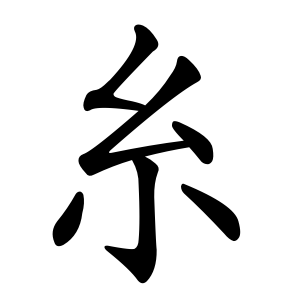糸
- thin silk;
- fine thread;
Etymology
The character primarily means "fine thread" (가는실 멱), though it is also read as "thread" (실 사). However, it was not added to the standard Hangul syllables or duplicate characters set.
The character 糸 is an ideogram representing twisted thread. Its origins trace back to the same form as 玄 (seen in ancient oracle and bronze inscriptions), deriving from an older form 𢆯 before differentiation. Also, the small component 幺 inside 幽 derives from this 𢆯 shape which originally appeared on the sides of 山.
So, 糸 visually and historically represents twisted thread, evolving alongside related characters from ancient forms.
Usage in Korean
Nowadays, 糸 and 絲 are often used interchangeably, and the original meaning tied to 糸 is rarely used, so conflicts like those seen with 缺 do not occur.
Alternative forms
Characters with 糸
- 納–to receive, to accept, to admit, to submit, to pay (tribute/tax), to enjoy
- 紐–to tie, bind, fasten, knot, cord, string
- 純–pure, genuine, unadulterated, simple, unmixed, sincere, wholehearted
- 紙–paper, writing material
- 紛–to be in disorder, tangled, confused, to scatter, to be chaotic
- 素–originally, fundamental, basis, plain, white
- 累–repeatedly, again and again, over and over
- 細–fine, thin, detailed, minute, to be slender, delicate
- 終–to finish, to end, to conclude
- 絃–string (of a musical instrument), chord, thread/line
- 組–to weave, to form, to organize, group, unit
- 統–to lead, to command, to govern, to unify, system, lineage, connection
- 綜–to gather together, to weave, to sum up, to integrate
- 綠–green, verdant, fresh, glossy
- 維–cord, warp thread, binding, to maintain
- 綱–main rope or cord of a net, guiding principle, essential outline
- 網–a net, a mesh
- 綿–cotton, soft, continuous, to extend unbroken
- 緊–tight, taut, firm, close, urgent
- 緋–scarlet silk, crimson, bright red cloth
- 緖–clue, beginning, origin, thread end, state of mind
- 線–line, thread, wire, connection
- 緞–silk, satin, fine woven cloth
- 緣–connection, fate, relationship (esp. karmic bond), cause, edge, margi
- 編–to weave, to compile, to arrange, to organize, to edit
- 緩–slow, not rapid, loose, slack, relaxed
- 緯–weft thread, ordering, regulating, latitude (in geography), pattern, principle
- 練–to practice, to train, to drill, to temper
- 縮–to shrink, to shorten, to contract, to draw in, to reduce
- 縱–vertical, lengthwise, to let loose, to indulge, to allow at will, to stretch, to extend, to release
- 總–all, to gather, to put together, to oversee, to sum up, to command, to supervise
- 績–weaving, spinning, to make cloth, achievement, merit, accomplishment
- 繁–to flourish, to prosper, to be numerous, luxuriant, complicated, rope of a boat
- 女戈火 (VIF)
- ⿱ 幺 小
